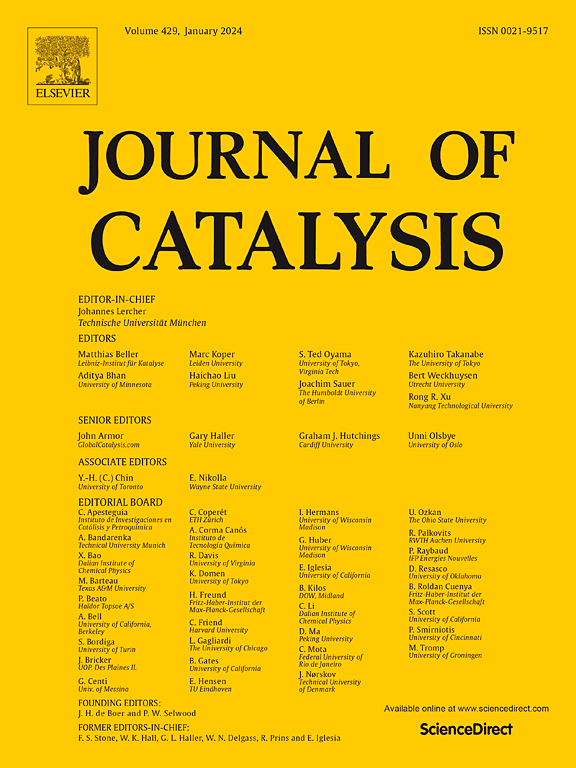PCN中的光调制氧化还原位点开关:实现整体水分解
IF 6.5
1区 化学
Q2 CHEMISTRY, PHYSICAL
引用次数: 0
摘要
聚合物氮化碳(PCN)已成为一种很有前途的光催化材料,但其在不同光源下的氧化还原位点动力学尚不清楚。在这项研究中,我们使用开尔文探针力显微镜(KPFM)和原位光沉积共催化剂来揭示PCN的氧化和还原位点的光诱导位移,表明这些位点不是固定的,而是在不同的辐照条件下动态重新配置的。理论计算进一步支持这一观察结果,表明激发波长影响PCN框架内的电荷分布。基于这些发现,我们建立了一个顺序的共催化剂加载策略:可见光照射选择性地将铂(Pt)还原到PCN上,而随后的模拟阳光照射促进特定位点的氧化,在原位形成还原和氧化共催化剂。该策略可以实现持续的光催化水分解,在纯水中实现化学计量的H2和O2生产。通过阐明光波长与氧化还原位点可逆性之间的相互作用,我们的研究结果挑战了静态活性位点的传统假设,并为设计可持续生产氢和氧的光催化系统提供了一个新的框架。本文章由计算机程序翻译,如有差异,请以英文原文为准。


Light-modulated redox site switching in PCN: Achieving overall water splitting
Polymeric carbon nitride (PCN) has emerged as a promising photocatalytic material, yet its redox site dynamics under varying light sources remain poorly understood. In this study, we employ Kelvin probe force microscopy (KPFM) and in situ photo-deposition of a co-catalyst to reveal light-induced shifts in PCN’s oxidation and reduction sites, demonstrating that these sites are not fixed but dynamically reconfigured under different irradiation conditions. Theoretical calculations further support this observation, showing that excitation wavelength influences charge distribution within the PCN framework. Building upon these findings, we establish a sequential co-catalyst loading strategy: visible light irradiation selectively reduces platinum (Pt) onto PCN, while subsequent simulated sunlight exposure facilitates site-specific oxidation, forming both reduction and oxidation co-catalysts in situ. This strategy enables sustained photocatalytic water splitting, achieving stoichiometric H2 and O2 production in pure water. By elucidating the interplay between light wavelength and redox site reversibility, our findings challenge conventional assumptions of static active sites and offer a new framework for designing light-responsive photocatalytic systems for sustainable hydrogen and oxygen production.
求助全文
通过发布文献求助,成功后即可免费获取论文全文。
去求助
来源期刊

Journal of Catalysis
工程技术-工程:化工
CiteScore
12.30
自引率
5.50%
发文量
447
审稿时长
31 days
期刊介绍:
The Journal of Catalysis publishes scholarly articles on both heterogeneous and homogeneous catalysis, covering a wide range of chemical transformations. These include various types of catalysis, such as those mediated by photons, plasmons, and electrons. The focus of the studies is to understand the relationship between catalytic function and the underlying chemical properties of surfaces and metal complexes.
The articles in the journal offer innovative concepts and explore the synthesis and kinetics of inorganic solids and homogeneous complexes. Furthermore, they discuss spectroscopic techniques for characterizing catalysts, investigate the interaction of probes and reacting species with catalysts, and employ theoretical methods.
The research presented in the journal should have direct relevance to the field of catalytic processes, addressing either fundamental aspects or applications of catalysis.
 求助内容:
求助内容: 应助结果提醒方式:
应助结果提醒方式:


